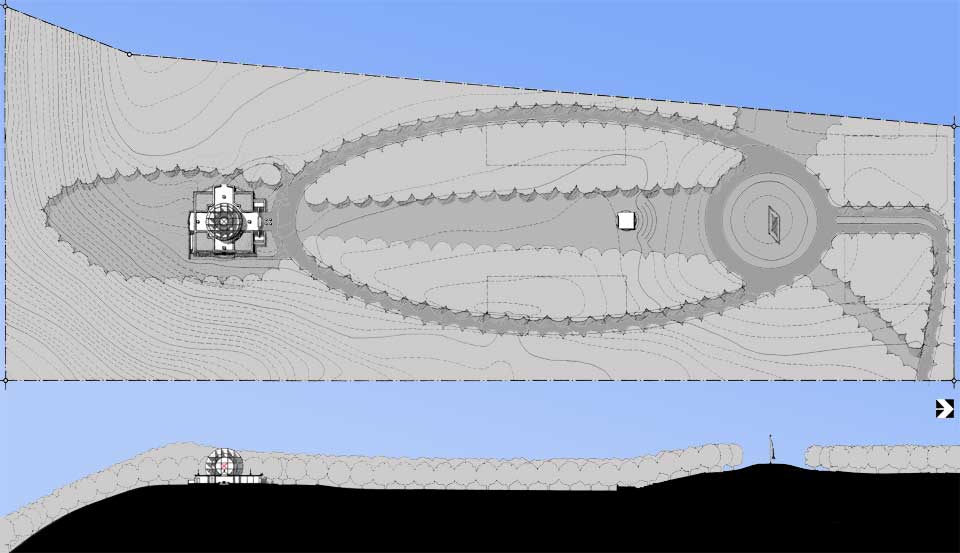
The elliptical drive opens the whole site for access (and future development) and distributes the parking so as to avoid an acute scarring of the landscape. As the cars are parked on a curve, there will be no long uninterrupted view of sun baked parked cars.
GENERAL INTENT
This memorial is a place steeped in paradox. It celebrates peace paid for by war; it freezes the flow of time; it evokes the spirit by inanimate material means; it honors the individual but represents many; it is a public manifestation of private and intimate remembrances; and it serves a civic purpose in a rural setting. It is appropriate that these paradoxes be poignantly expressed. But foremost, the memorial must serve as a touchstone marking a heroic and dignified place where people may communicate and ceremoniously share their inner lives with one another through symbolic behavior.
The Circle and the Sphere
Since the time of the ancients the circle has represented heaven and the eternal spirit for it has neither beginning nor end. “An old text says that God is a circle whose center is everywhere but whose circumference is nowhere.” (source 1) It is a polygon with an infinite number of sides. A circle orients equally in all directions in the plane within which it lies and a sphere orients equally in all directions in space; these properties relate these forms to the field of the absolute. The Great Round has associations with the egg as a symbol of rebirth, with the “cosmos as a unity within the womb-cavern of the Great Goddess, encircling one’s being in a nurturing matrix, and centered in the Great Mother” (source 2), the protective, and protected, homeland.
The Square and the Grid
From antiquity the square has been a symbol of the material world, representing the four elements (earth, water, air, and fire) and it is also associated with masculine strength while the circle is associated more with feminine qualities. The square implies an imperfect unity because it possesses a fundamental duality by the opposition in the orientation of its sides. It makes a synthesis of the horizontal and the vertical which represents the passive and the active principles respectively; i.e. passive submission to the ubiquitous invisible gravity and the eroding entropic winds of fate, versus the magical power to take action against a sea of troubles by exercising the will and waging war on tyranny and chaos.
When the square is repeated to form a grid matrix it has the strongest archetypal associations with the techne-logos orientation of any common geometric pattern, i.e., it strongly connotes the rational mind, analytical science, and the high level accomplishments of engineering made possible through mass production technology. The grid suggests that the cosmos is “a great machine knowable by the human intellect through science.” (source 3) The grid is also a geometric archetype of democracy. These attitudes reflect to a large degree the spirit of the twentieth century.
THE SQUARING OF THE CIRCLE
The Quadrature of the Circle
The squaring of the circle achieves a synchronicity between the spiritual and the material worlds. It has had great significance for geometer-cosmologists because it represents the circle, which is pure, infinite and absolute eternal spirit, being brought into balance with the square, which represents the finite and relative world of duality
“When a near-equality is drawn between the circle and the square, the infinite is able to express its dimensions of qualities through the finite.” (source 4)
ICONOGRAPHY, SEMIOLOGY, & POETIC DEVICES
The Framing of the Flags
The primary iconography is that of the U.S. and Alabama flags. Each flag represents the fealty of the veterans of the four wars; the U.S. flag identifies that it is the country’s values which have been defended. The entry onto the site coincides with the landscape vignette of a great U.S. banner which is supported from a large square Cor-ten® steel frame located on the highest naturally occurring point of (sacred) ground and framing a vista to the memorial sphere. This introduces the formal and symbolic themes of squaring the circle (e.g., the perimeter of the framing square equals the circumference of the memorial sphere, a geometric theme and symbol which is repeated several times in the design of the memorial). The American flag being framed by the large square on the hill is intended to signify the land, the country in its material manifestation, being filled with the patriotic spirit. The remoteness of the memorial sphere (or globe), which from this view frames the infinity of the sky and the distant horizon, is a reminder that the commemorated wars occurred in distant lands.
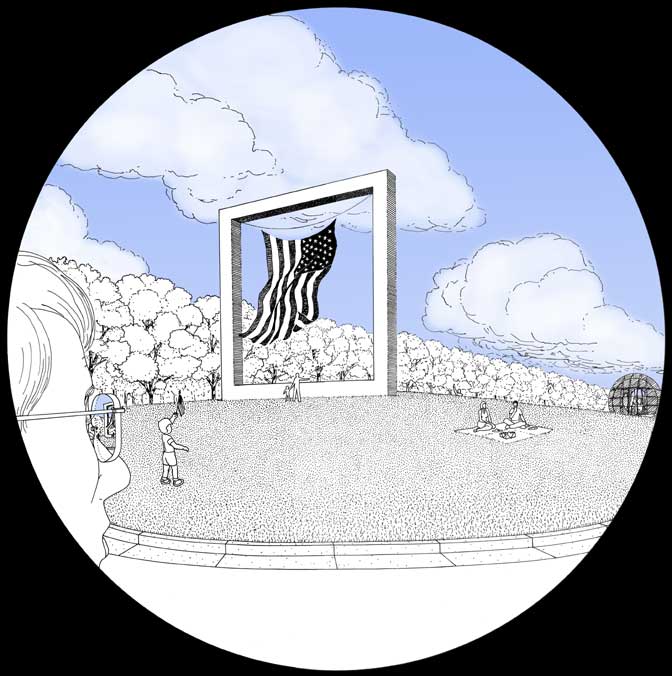
VIEW APPROACHING MEMORIAL FROM THE NORHTWEST
THE QUADRATURE OF THE SPHERE
The cubing of the sphere literally brings another dimension to this symbology. It provides for the physical occupation of the symbol in space and thus becomes the basis for defining a sacred place. In the memorial design the qualitites of the circle, the Great Round, the square, the cube, and the square grid are brought into poetic synthesis which marries their identities with all the richness of their paradoxical inconsistencies and metaphorical ambiguities.

NORTH ELEVATION
The square addresses the plane of the earth by orienting to the four cardinal points of the compass and it embodies the fundamental relationship of the horizontal horizon of the earth with the vertical stature of an erect human being, which together form a right angle. (The intense use of the right angle is metaphorically significant in relation to the Alabama state motto,
“We dare defend our rights”,
which is prominently displayed as an epigram above the entry portico on the approach side of the memorial.) The cube establishes most clearly the fundamental right-angle dimensions of physical existence. The “battering” of the outside of the protective memorial building’s beiige colored concrete walls makes poignant the rigor of the grid as it occurs everywhere else.
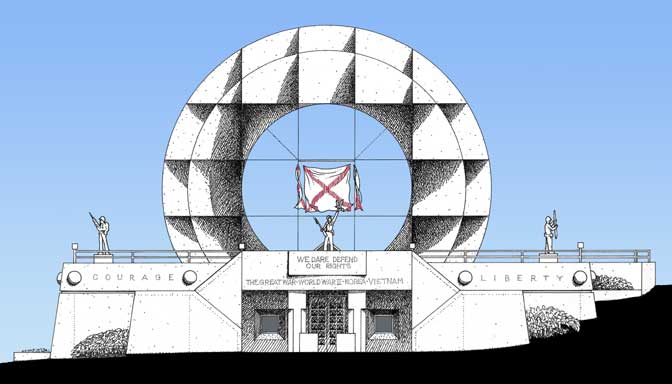
SECTION PERSPECTIVE VIEWING SOUTH
The Alabama flag, originally being square in proportion with a diagonal cross dividing its field into quadrants, represents the idea of four. The memorial also has four of these banners suspended on a square support frame about a cubic void at the very center of the cubed sphere. An other American flag drapes over the sarcophagus containing the body of an unknown soldier who lies in state at the heart of the lower level base of the memorial sphere. This sacred tomb is illuminated by a skylight with a form geometrically similar to that of the Great Pyramid of Cheops/Khufu (which also embodies the quadrature of the circle and the cubing of the sphere in its proportions - see source 5).
PERSPECTIVE PLAN OF UPPER LEVEL
The pyramidal skylight, which is vertically aligned with the square frame supporting the four Alabam flags, has mullions which form a simile of the Alabama state flag. This honorific axis mundi is further articulated by the four true to scale representational statues of soldiers, each one representing a soldier from one of the four wars. Alternately positioned with these statues on the roof of the bunker-like memorial building are four quadrants of fertile and green earth (to complement the red steel), each with a corner missing, signifying the presence of the absence of those brave soldiers who have returned to the ocean of the cosmic void.
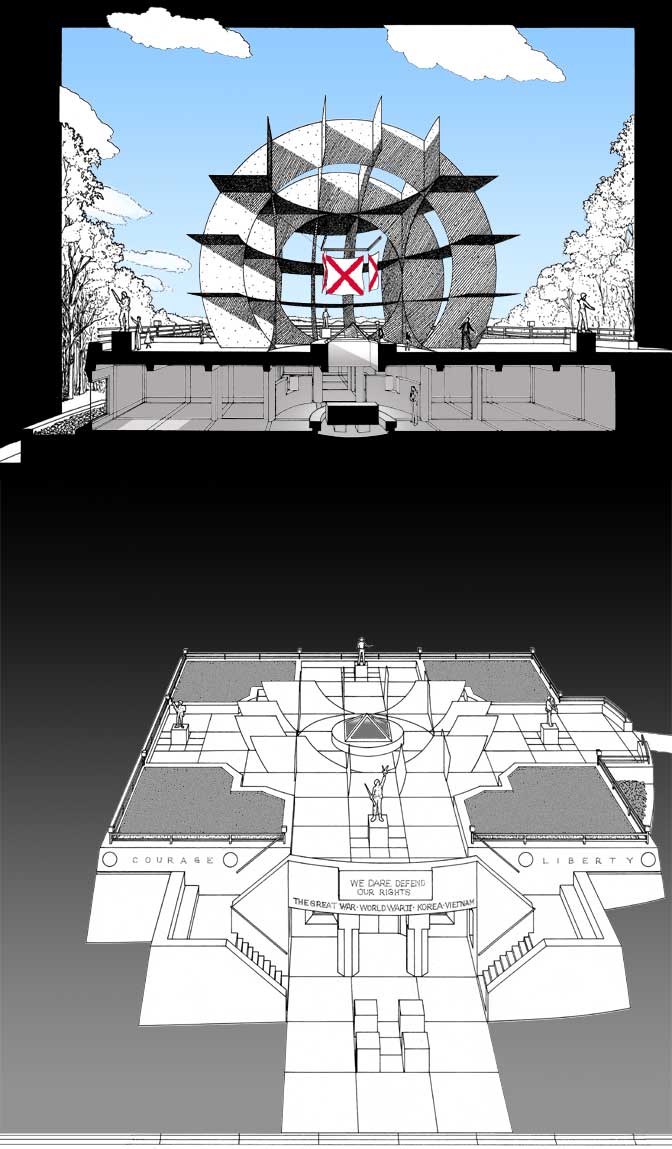
MEMORIAL PLANS
NORTH is to the bottom
Rollover Image: place cursor over plan image to see the lower level interior plan.
Sacrifice and the God of War
the nine-square grid which articulates each of the three right angle dimensions of space is an embodiment of a five square cross, which marks the sacred center, and the four corner squares which represent the four wars. Mars, the Roman god of war, is also the name of the fourth of nine planets as counted from the sun and is further implied metaphorically by the 3/4 inch thick plates of Cor-ten® steel of which the memorial sphere/cube is constructed. Steel/iron is the acknowledged metal of technology and war. (As a side note, the elliptical path of the approach drive is a subtle reminder that Johannes Kepler made his insight into the elliptical nature of planetary orbits by meticulously studying the orbit of the red planet Mars - see souce 6). The Corten® steel of the memorial sphere/cube, besides being red, also reflects the notion that the eternal ideas represented by the cubed-sphere as well as its physical viability are ultimately protected by a shield of corrosion which covers the metal’s surface. The corroded steel has sacrificed itself to protect the integrity of the remaining metal. This is an allegorical expression that the destruction and sacrifice of war must at times occur to protect what we value and desire to preserve. This rust is also a tactile and mnemonic feature which can leave a mark on the skin of the visitor.
Circles & Squares in Plan
Both the upper and level plans possess central formal features which explicitly juxtapose a circle and square symmetrically superimposed upon each other with identical perimeters. In the lower level plan, the wall segment arcs have voids which form closure on a square representing the presence of the absence of the physical being. This is to honor the tomb as an icon and symbol of all those who gave the last full measure of devotion.
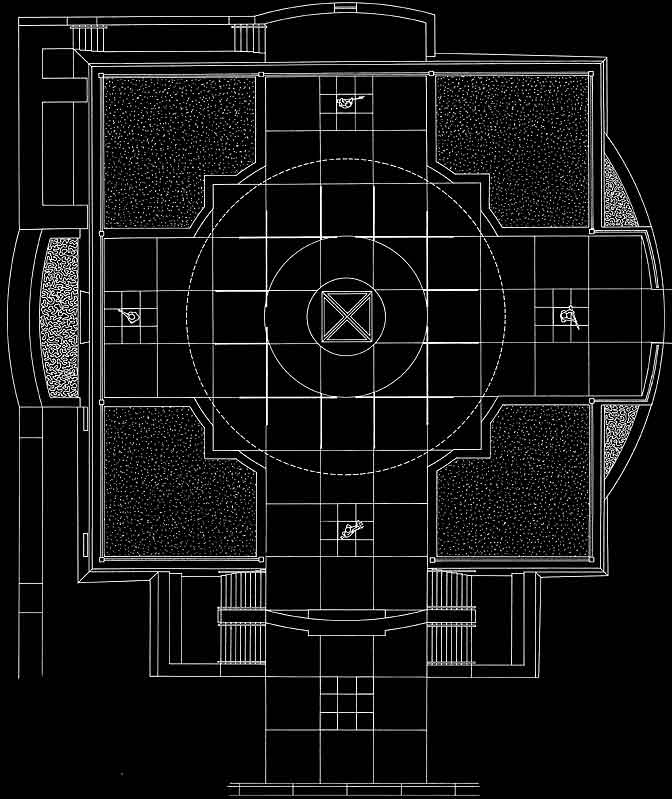
SOUTHEAST ELEVATION
Hyperspace and the Machine of Doom
The space of the memorial, the cube-sphere, is also an allusion to the conception of space as developed by Albert Einstein and other physicists of the twentieth century; i.e., it is relative to the observer (see the discussion on false perspective in ... Aesthetics in Site Design) and it suggests the relativistic law that gravitational fields curve space. The false perspective approach and the geometry of the memorial piece poetically trope the warping of Newton’s absolutely time-constant and rectilinear space grid by the solemn gravity of the memorial’s raison d’etre. As this revolutionary way of conceiving of space and the universe occurred at the beginning of the 20th century, it is fitting as a temporal symbolic gesture to reflect this understanding in the memorial. Its imagery also resembles another terribly significant discovery by physicists of the twentieth century, the splitting of the atom and its subsequent employment as a military instrument of fear and destruction. The release of this mushroom cloud genie (nuclear warfare) must never be forgotten and deserves expression in the memorial.
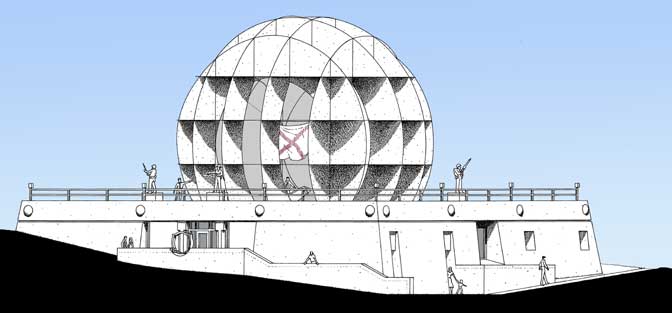
1. Munari, Bruno, The Discovery of the Circle (New York: George Wittenborn, Inc., 1966), p. 5.
2. Lobell, Mimi, “Spatial Archetypes”, Revision: vol. 6, fall, 1983, p. 76
3. Lobell, pp. 81-82.
4. Lawlor, Robert, Sacred Geometry: Philosophy and Practice (New York: thames & Hudson, 1982), p. 74.
5. Thompkins, Peter, Secrets of the Great Pyramid (New York: Harper & Row, 1971), pp. 196-200.
6. Layzer, David, Constructing the Universe, Scientific American Library, 1984, pp. 47-53.